Understanding the Multi-Faceted Drivers of Increasing Coal Consumption in Indonesia
Abstract
1. Introduction
1.1. Overview of Coal Consumption in Indonesia
1.2. Government Policy Landscape
1.3. Problems Caused by Rising Coal Consumption
2. Materials and Methods
2.1. Study Design
2.2. Review of Decomposition Analysis Literature
2.3. Method in This Study and Data Sources
3. Results
3.1. Drivers of Changes in Aggregate Coal Consumption
3.2. Figures, Tables and Schemes
4. Discussion
5. Conclusions and Policy Recommendations
5.1. Key Findings
5.2. Policy Recommendations
Author Contributions
Funding
Conflicts of Interest
References
- IPCC. Global Warming of 1.5 °C: Summary for Policy Makers. 2018. Available online: http://report.ipcc.ch/sr15/pdf/sr15_spm_final.pdf (accessed on 10 October 2018).
- Yanguas Parra, P.; Ganti, G.; Brecha, R.; Hare, B.; Schaeffer, M.; Fuentes, U. Global and Regional Coal Phase-Out Requirements of the Paris Agreement: Insights from the IPCC Special Report on 1.5 °C. 2019. Available online: https://climateanalytics.org/publications/2019/coal-phase-out-insights-from-the-ipcc-special-report-on-15c-and-global-trends-since-2015/ (accessed on 10 October 2019).
- Shearer, C.; Myllyvirta, L.; Yu Aitken, G.; Mathew-Shah, N.; Dallos, G.; Nace, T. Boom and Bust 2020: Tracking the Global Coal Pipeline. 2020. Available online: https://endcoal.org/wpcontent/uploads/2020/03/BoomAndBust_2020_English.pdf (accessed on 10 July 2020).
- Cui, R.Y.; Cui, R.Y.; Hultman, N.; Edwards, M.R.; He, L.; Sen, A.; Surana, K.; Nace, T. Quantifying operational lifetimes for coal power plants under the Paris goals. Nat. Commun. 2019, 10, 1–9. [Google Scholar] [CrossRef] [PubMed]
- Edenhofer, O.; Steckel, J.C.; Jakob, M.; Bertram, C. Reports of coal’s terminal decline may be exaggerated. Environ. Res. Lett. 2018, 13, 24019. [Google Scholar] [CrossRef]
- Blondeel, M.; de Graaf, T.V.; Haesebrouck, T. Moving beyond coal: Exploring and explaining the Powering Past Coal Alliance. Energy Res. Soc. Sci. 2020, 59, 101304. [Google Scholar] [CrossRef]
- Oberschelp, C.; Pfister, S.; Raptis, C.E.; Hellweg, S. Global emission hotspots of coal power generation. Nat. Sustain. 2019, 2, 113. [Google Scholar] [CrossRef]
- Newell, P.; Simms, A. Towards a fossil fuel non-proliferation treaty. Clim. Policy 2019, 19, 1–12. [Google Scholar] [CrossRef]
- Garg, A.; Steckel, J.C. Chapter 2: Bridging the Gap—Phasing Out Coal; The Emissions Gap Report 2017; United Nations Environment Programme (UNEP): Nairobi, Kenya, 2017. [Google Scholar]
- Jewell, J.; Vinichenko, V.; Nacke, L.; Cherp, A. Prospects for powering past coal. Nat. Clim. Chang. 2019, 9, 592–597. [Google Scholar] [CrossRef]
- Rentier, G.; Lelieveldt, H.; Kramer, G.J. Varieties of coal-fired power phase-out across Europe. Energy Policy 2019, 132, 620–632. [Google Scholar] [CrossRef]
- Trencher, G.; Healy, N.; Hasegawa, K.; Asuka, J. Discursive resistance to phasing out coal-fired electricity: Narratives in Japan’s coal regime. Energy Policy 2019, 132, 782–796. [Google Scholar] [CrossRef]
- Spencer, T.; Colombier, M.; Sartor, O.; Garg, A.; Tiwari, V.; Burton, J.; Caetano, T.; Green, F.; Teng, F.; Wiseman, J. The 1.5°C target and coal sector transition: At the limits of societal feasibility. Clim. Policy 2018, 18, 335–351. [Google Scholar] [CrossRef]
- Zhao, S.; Alexandroff, A. Current and future struggles to eliminate coal. Energy Policy 2019, 129, 511–520. [Google Scholar] [CrossRef]
- Riahi, K.; Dentener, F.; Gielen, D.; Grubler, A.; Jewell, J.; Klimont, Z.; Krey, V.; McCollum, D.L. Chapter 17: Energy pathways for sustainable development. In Global Energy Assessment: Toward a Sustainable Future; GEA Writing Team, Ed.; Cambridge University Press: Cambridge, UK; IIASA: Laxenburg, Austria, 2012; pp. 1203–1306. [Google Scholar]
- Winkler, H.; Spalding-Fecher, R.; Tyani, L. Comparing developing countries under potential carbon allocation schemes. Clim. Policy 2002, 2, 303–318. [Google Scholar] [CrossRef]
- Kalkuhl, M.; Steckel, J.C.; Montrone, L.; Jakob, M.; Peters, J.; Edenhofer, O. Successful coal phase-out requires new models of development. Nat. Energy 2019, 4, 897–900. [Google Scholar] [CrossRef]
- Steckel, J.C.; Edenhofer, O.; Jakob, M. Drivers for the renaissance of coal. Proc. Natl. Acad. Sci. USA 2015, 112, E3775–E3781. [Google Scholar] [CrossRef] [PubMed]
- Cornot-Gandolphe, S. The Role of Coal in Southeast Asia’s Power Sector and Implications for Global and Regional Coal Trade. 2016. Available online: https://www.oxfordenergy.org/wpcms/wp-content/uploads/2016/12/The-role-of-coal-in-Southeast-Asias-power-sector-CL-4.pdf (accessed on 15 September 2019).
- Betz, M.R.; Partridge, M.D.; Farren, M.; Lobao, L. Coal mining, economic development, and the natural resources curse. Energy Econ. 2015, 50, 105–116. [Google Scholar] [CrossRef]
- Dutu, R. Challenges and policies in Indonesia’s energy sector. Energy Policy 2016, 98, 513–519. [Google Scholar] [CrossRef]
- Koplitz, S.N.; Jacob, D.J.; Sulprizio, M.P.; Myllyvirta, L.; Reid, C. Burden of disease from rising coal-fired power plant emissions in Southeast Asia. Environ. Sci. Technol. 2017, 51, 1467–1476. [Google Scholar] [CrossRef]
- Arinaldo, D.; Adiatma, J.C. Indonesia’s Coal Dynamics: Toward A Just Energy Transition. 2019. Available online: http://iesr.or.id/wp-content/uploads/2019/08/Indonesias-Coal-Dynamics_Toward-a-Just-Energy-Transition.pdf (accessed on 15 October 2019).
- Atteridge, A.; Aung, M.T.; Nugroho, A. Contemporary Coal Dynamics in Indonesia. 2018. Available online: https://www.sei.org/wp-content/uploads/2018/06/contemporary-coal-dynamics-in-indonesia.pdf (accessed on 17 June 2019).
- IEA. Coal Medium-Term Market Report 2015. Available online: https://webstore.iea.org/medium-term-coal-market-report-2015 (accessed on 17 August 2019).
- Wu, X.; Chen, G. Coal use embodied in globalized world economy: From source to sink through supply chain. Renew. Sustain. Energy Rev. 2018, 81, 978–993. [Google Scholar] [CrossRef]
- BP. BP Statistical Review of World Energy. 2018. Available online: https://www.bp.com/en/global/corporate/energy-economics/statistical-review-ofworld-energy.html (accessed on 3 February 2019).
- GEM. Global Coal Plant Tracker. 2019. Available online: https://endcoal.org/global-coal-plant-tracker/ (accessed on 18 September 2019).
- EEFA. Indonesia: 2019 Energy Plan Falls Short. 2019. Available online: https://ieefa.org/ieefa-indonesia-2019-energy-plan-falls-short/ (accessed on 24 September 2019).
- PLN. Electricity Supply Business Plan 2019–2028. 2019. Available online: http://alpha.djk.esdm.go.id/pdf/RUPTL/RUPTL%20PLN%202019-2028.pdf (accessed on 25 March 2019).
- Hamdi, E. The Case for System Transformation in Indonesia. 2019. Available online: https://ieefa.org/wp-content/uploads/2019/11/IEEFA_The-Case-for-System-Transformation-in-Indonesia_November-2019.pdf (accessed on 25 November 2019).
- Tumiwa, F.; Pujantoro, M.; Godron, P. A Roadmap for Indonesia’s Power Sector: How Renewable Energy Can Power Java-Bali and Sumatra. 2019. Available online: http://iesr.or.id/wp-content/uploads/2019/04/COMS-PUB-0021_A-Roadmap-for-Indonesia_s-Power-Sector.pdf (accessed on 24 October 2019).
- Kim, H.-M.; Yoo, S.-H. Coal consumption and economic growth in Indonesia. Energy Sources Part B Econ. Plan. Policy 2016, 11, 547–552. [Google Scholar] [CrossRef]
- Boulle, M. The hazy rise of coal in Kenya: The actors, interests, and discursive contradictions shaping Kenya’s electricity future. Energy Res. Soc. Sci. 2019, 56, 101205. [Google Scholar] [CrossRef]
- Kuchler, M.; Bridge, G. Down the black hole: Sustaining national socio-technical imaginaries of coal in Poland. Energy Res. Soc. Sci. 2018, 41, 136–147. [Google Scholar] [CrossRef]
- Wang, Q.; Li, R. Journey to burning half of global coal: Trajectory and drivers of China’s coal use. Renew. Sustain. Energy Rev. 2016, 58, 341–346. [Google Scholar] [CrossRef]
- MEMR. Handbook of Energy and Economic Statistics of Indonesia 2016; Ministry of Energy and Mineral Resources Indonesia: Jakarta, Indonesia, 2017. [Google Scholar]
- World-Bank. World Bank Data: Urban Population. 2019. Available online: https://data.worldbank.org/indicator/SP.URB.TOTL.in.zs (accessed on 3 February 2019).
- Kurniawan, R.; Sugiawan, Y.; Managi, S. Cleaner energy conversion and household emission decomposition analysis in Indonesia. J. Clean. Prod. 2018, 201, 334–342. [Google Scholar] [CrossRef]
- Avtar, R.; Tripathi, S.; Aggarwal, A.K.; Kumar, P. Population–Urbanization–Energy Nexus: A Review. Resources 2019, 8, 136. [Google Scholar] [CrossRef]
- Ang, B.W. LMDI decomposition approach: A guide for implementation. Energy Policy 2015, 86, 233–238. [Google Scholar] [CrossRef]
- Zhu, C.; Du, W. A Research on driving factors of carbon emissions of road transportation industry in six Asia-Pacific countries based on the LMDI Decomposition method. Energies 2019, 12, 4152. [Google Scholar] [CrossRef]
- Zhang, S.; Yang, F.; Liu, C.; Chen, X.; Tan, X.; Zhou, Y.; Guo, F.; Jiang, W. Study on global industrialization and industry emission to achieve the 2 °C goal based on MESSAGE model and LMDI approach. Energies 2020, 13, 825. [Google Scholar] [CrossRef]
- NEC. National Energy Policy in Indonesia and Its Alignment to SDGs and Paris Agreement; National Energy Council: Jakarta, Indonesia, 2019. [Google Scholar]
- IEA. Coal 2018: Analysis and Forecasts to 2023. 2018. Available online: https://www.iea.org/coal2018/ (accessed on 27 August 2019).
- MEMR. Handbook of Energy and Economic Statistics of Indonesia 2018. 2018. Available online: https://www.esdm.go.id/assets/media/content/content-handbook-of-energy-and-economic-statistics-of-indonesia-2018-final-edition.pdf (accessed on 3 March 2019).
- Cornot-Gandolphe, S. Indonesia’s Electricity Demand and the Coal Sector: Export or Meet Domestic Demand? 2017. Available online: https://www.oxfordenergy.org/publications/indonesias-electricity-demand-coal-sector-export-meet-domestic-demand/ (accessed on 26 October 2019).
- Chawla, Y.; Kowalska-Pyzalska, A.; Widayat, W. Consumer willingness and acceptance of smart meters in Indonesia. Resources 2019, 8, 177. [Google Scholar] [CrossRef]
- Suharsono, A.; Gencsu, I. G20 Coal Subsidies: Indonesia. 2019. Available online: https://www.odi.org/sites/odi.org.uk/files/resource-documents/12746.pdf (accessed on 30 November 2019).
- ADB. Republic of Indonesia: Sustainable and Inclusive Energy Program. 2018. Available online: https://www.adb.org/sites/default/files/project-documents/48323/48323-001-tacr-en_0.pdf (accessed on 29 October 2019).
- Market-Forces. Foreign Finance to Indonesian Coal. 2019. Available online: https://www.marketforces.org.au/research/indonesia/public-finance-to-indonesian-coal/ (accessed on 20 August 2019).
- Bridle, R. Missing the 23 Per Cent Target: Roadblocks to the Development of Renewable Energy in Indonesia. 2018. Available online: https://www.iisd.org/library/missing-23-cent-target-roadblocks-development-renewable-energy-indonesia (accessed on 25 November 2019).
- IRENA. Renewable Energy Prospects: Indonesia. In REmap 2030. 2017. Available online: https://www.irena.org/publications/2017/Mar/Renewable-Energy-Prospects-Indonesia (accessed on 20 September 2019).
- Abood, S.A.; Lee, J.S.H.; Burivalova, Z.; Garcia-Ulloa, J.; Koh, L.P. Relative contributions of the logging, fiber, oil palm, and mining industries to forest loss in Indonesia. Conserv. Lett. 2015, 8, 58–67. [Google Scholar] [CrossRef]
- Muhdar, M. Law aspect of coal mining reclamation in east Kalimantan Forestry. Mimb. Huk. Fak. Hukum Univ. Gadjah Mada 2015, 27, 472–486. [Google Scholar] [CrossRef]
- Arvirianty, A. 3000 Companies Have Not Submitted the Post-Mining Guarantee Fund. Consumer News and Business Channel Indonesia 2019. Available online: https://www.cnbcindonesia.com/news/20190711182742-4-84301/esdm-3000-perusahaan-belum-kasih-jaminan-pasca-tambang (accessed on 20 September 2019).
- Dwiki, S. Development of environmental policy in Indonesia regarding mining industry in comparison with the United States and Australia: The lesson that can be learned. Evergreen 2018, 5, 50–57. [Google Scholar] [CrossRef]
- Brigden, K.; Santillo, D.; Johnston, P. Metals in Coal Mining & Processing Wastewaters from Indonesia. 2014. Available online: https://www.greenpeace.org/archive-indonesia/PageFiles/645408/FULL%20REPORT%20Coal%20Mining%20Polluting%20South%20Kalimantan%20Water_Lowres.pdf (accessed on 27 September 2019).
- Son, M.; Anhäuser, A.; Sivalingam, N.; Farrow, A.; Myllyvirta, L. Double Standard: How Japan’s Financing of Highly Polluting Overseas Coal Plants Endangers Public Health. 2019. Available online: https://www.greenpeace.org/southeastasia/publication/2887/double-standard-how-japans-financing-of-highly-polluting-overseas-coal-plants-endangers-public-health/ (accessed on 25 October 2019).
- Sanchez, L.; Luan, B. The Health Cost of Coal in Indonesia. 2018. Available online: https://www.iisd.org/sites/default/files/publications/health-cost-coal-indonesia.pdf (accessed on 27 August 2019).
- Chen, H.; Doukas, A.; Schmidt, J.; Vollmer, S.L. The Carbon Trap: How International Coal Finance Undermines the Paris Agreement. Available online: https://www.nrdc.org/resources/carbon-trap-how-international-coal-finance-undermines-paris-agreement (accessed on 25 March 2019).
- Chung, Y. Overpaid and Underutilized: How Capacity Payments to Coal-Fired Power Plants Could Lock Indonesia into a High-Cost Electricity Future. 2017. Available online: http://ieefa.org/wp-content/uploads/2017/08/Overpaid-and-Underutilized_How-Capacity-Payments-to-Coal-Fired-Power-Plants-Could-Lock-Indonesia-into-a-High-Cost-Electricity-Future-_August2017.pdf (accessed on 25 March 2019).
- Hakko, H.; Lou, M. Uncertain and Harmful: Japanese Coal Investments in Indonesia. 2018. Available online: https://www.greenpeace.org/japan/sustainable/publication/2018/12/06/6544/ (accessed on 23 March 2019).
- PWC. Power in Indonesia: Investment and Taxation Guide November 2018. 2018. Available online: https://www.pwc.com/id/en/publications/assets/eumpublications/utilities/power-guide-2018.pdf (accessed on 17 September 2019).
- Tang, X.; Jin, Y.; McLellan, B.C.; Wang, J.; Li, S. China’s coal consumption declining—Impermanent or permanent? Resour. Conserv. Recycl. 2018, 129, 307–313. [Google Scholar] [CrossRef]
- De Oliveira-De Jesus, P.M. Effect of generation capacity factors on carbon emission intensity of electricity of Latin America & the Caribbean, a temporal IDA-LMDI analysis. Renew. Sustain. Energy Rev. 2019, 101, 516–526. [Google Scholar]
- Fujii, H.; Managi, S. Decomposition of toxic chemical substance management in three US manufacturing sectors from 1991 to 2008. J. Ind. Ecol. 2013, 17, 461–471. [Google Scholar] [CrossRef]
- Yang, J.; Zhang, W.; Zhang, Z. Impacts of urbanization on renewable energy consumption in China. J. Clean. Prod. 2016, 114, 443–451. [Google Scholar] [CrossRef]
- Ang, B.W.; Liu, N. Handling zero values in the logarithmic mean Divisia index decomposition approach. Energy Policy 2007, 35, 238–246. [Google Scholar] [CrossRef]
- Tanoto, Y.; Praptiningsih, M. Factors decomposition of Indonesia’s household electricity consumption. Eng. J. 2013, 17, 19–28. [Google Scholar] [CrossRef][Green Version]
- Chen, J.J.; Pitt, M.M. Sources of change in the demand for energy by Indonesian households: 1980–2002. Energy Econ. 2017, 61, 147–161. [Google Scholar] [CrossRef]
- Wang, H.; Zhou, P.; Xie, B.C.; Zhang, N. Assessing drivers of CO2 emissions in China’s electricity sector: A metafrontier production-theoretical decomposition analysis. Eur. J. Oper. Res. 2019, 275, 1096–1107. [Google Scholar] [CrossRef]
- Chen, L.; Duan, Q. Decomposition analysis of factors driving CO2 emissions in Chinese provinces based on production-theoretical decomposition analysis. Nat. Hazards 2016, 84, 267–277. [Google Scholar] [CrossRef]
- Wang, M.; Feng, C. Exploring the driving forces of energy-related CO2 emissions in China’s construction industry by utilizing production-theoretical decomposition analysis. J. Clean. Prod. 2018, 202, 710–719. [Google Scholar] [CrossRef]
- Su, B.; Ang, B.W.; Li, Y. Input-output and structural decomposition analysis of Singapore’s carbon emissions. Energy Policy 2017, 105, 484–492. [Google Scholar] [CrossRef]
- Wei, J.; Huang, K.; Yang, S.; Li, Y.; Hu, T.; Zhang, Y. Driving forces analysis of energy-related carbon dioxide (CO2) emissions in Beijing: An input–output structural decomposition analysis. J. Clean. Prod. 2017, 163, 58–68. [Google Scholar] [CrossRef]
- Yuan, R.; Zhao, T. Changes in CO2 emissions from China’s energy-intensive industries: A subsystem input–output decomposition analysis. J. Clean. Prod. 2016, 117, 98–109. [Google Scholar] [CrossRef]
- Jeroen, R. Comparing structural and index decomposition analysis. Energy Econ. 2003, 25, 39–64. [Google Scholar]
- Ang, B.W.; Zhang, F.Q. A survey of index decomposition analysis in energy and environmental studies. Energy 2000, 25, 1149–1176. [Google Scholar] [CrossRef]
- Rüstemoğlu, H.; Andrés, A.R. Determinants of CO2 emissions in Brazil and Russia between 1992 and 2011: A decomposition analysis. Environ. Sci. Policy 2016, 58, 95–106. [Google Scholar] [CrossRef]
- Sun, J. Changes in energy consumption and energy intensity: A complete decomposition model. Energy Econ. 1998, 20, 85–100. [Google Scholar] [CrossRef]
- Reddy, B.S.; Ray, B.K. Understanding industrial energy use: Physical energy intensity changes in Indian manufacturing sector. Energy Policy 2011, 39, 7234–7243. [Google Scholar] [CrossRef]
- Zhang, M.; Bai, C.; Zhou, M. Decomposition analysis for assessing the progress in decoupling relationship between coal consumption and economic growth in China. Resour. Conserv. Recycl. 2018, 129, 454–462. [Google Scholar] [CrossRef]
- Chong, C.; Ma, L.; Li, Z.; Ni, W.; Song, S. Logarithmic mean Divisia index (LMDI) decomposition of coal consumption in China based on the energy allocation diagram of coal flows. Energy 2015, 85, 366–378. [Google Scholar] [CrossRef]
- Lan, J.; Malik, A.; Lenzen, M.; McBain, D.; Kanemoto, K. A structural decomposition analysis of global energy footprints. Appl. Energy 2016, 163, 436–451. [Google Scholar] [CrossRef]
- Wang, Q.; Zeng, Y.-E.; Wu, B.-W. Exploring the relationship between urbanization, energy consumption, and CO2 emissions in different provinces of China. Renew. Sustain. Energy Rev. 2016, 54, 1563–1579. [Google Scholar] [CrossRef]
- Yeo, Y.; Shim, D.; Lee, J.D.; Altmann, J. Driving Forces of CO2 Emissions in Emerging Countries: LMDI Decomposition Analysis on China and India’s Residential Sector. Sustainability 2015, 7, 16108–16129. [Google Scholar] [CrossRef]
- Chong, C.H.; Tan, W.X.; Ting, Z.J.; Liu, P.; Ma, L.; Li, Z.; Ni, W. The driving factors of energy-related CO2 emission growth in Malaysia: The LMDI decomposition method based on energy allocation analysis. Renew. Sustain. Energy Rev. 2019, 115, 109356. [Google Scholar] [CrossRef]
- OECD. Coal-Fired Heat and Electricity Generation Efficiency. 2015. Available online: https://www.oecd-ilibrary.org/economics/oecd-economic-surveys-indonesia-2015/coal-fired-heat-and-electricity-generation-efficiency-2011_eco_surveys-idn-2015-graph50-en (accessed on 17 April 2019).
- Pambudi, N.A. Geothermal power generation in Indonesia, a country within the ring of fire: Current status, future development and policy. Renew. Sustain. Energy Rev. 2018, 81, 2893–2901. [Google Scholar] [CrossRef]
- Fan, K.; Nam, S. Accelerating Geothermal Development in Indonesia: A Case Study in the Underutilization of Geothermal Energy. Consilience 2018, 19, 103–129. [Google Scholar]
- Rakhmadi, R.; Haesra, A.; Wijaya, M.E. Climate Policy Initiative Energizing Renewables in Indonesia: Optimizing Public Finance Levers to Drive Private Investment. 2018. Available online: https://climatepolicyinitiative.org/publication/energizing-renewables-in-indonesia-optimizing-public-finance-levers-to-drive-private-investment/ (accessed on 5 November 2019).
- Sugiawan, Y.; Managi, S. The environmental Kuznets curve in Indonesia: Exploring the potential of renewable energy. Energy Policy 2016, 98, 187–198. [Google Scholar] [CrossRef]
- World-Bank. Indonesia: Toward Universal Access to Clean Cooking. 2013. Available online: http://documents.worldbank.org/curated/en/105441468044144806/Indonesia-Toward-universal-access-to-clean-cooking (accessed on 27 August 2019).
- Sukarno, I.; Matsumoto, H.; Susanti, L.; Kimura, R. Urban energy consumption in a city of Indonesia: General overview. Int. J. Energy Econ. Policy 2015, 5, 360–373. [Google Scholar]
- Tewathia, N. Determinants of the household electricity consumption: A case study of Delhi. Int. J. Energy Econ. Policy 2014, 4, 337–348. [Google Scholar]
- Batih, H.; Sorapipatana, C. Characteristics of urban households’ electrical energy consumption in Indonesia and its saving potentials. Renew. Sustain. Energy Rev. 2016, 57, 1160–1173. [Google Scholar] [CrossRef]
- Bloch, H.; Rafiq, S.; Salim, R. Coal consumption, CO2 emission and economic growth in China: Empirical evidence and policy responses. Energy Econ. 2012, 34, 518–528. [Google Scholar] [CrossRef]
- Jones, G.W. Migration and Urbanization in China, India and Indonesia: An Overview. In Contemporary Demographic Transformations in China, India and Indonesia; Springer: Cham, Switzerland, 2016; pp. 271–276. [Google Scholar]
- IEA. Reducing Emissions from Fossil-Fired Generation Indonesia, Malaysia and Viet Nam. 2016. Available online: https://webstore.iea.org/insights-series-2016-reducing-emissions-in-fossil-fired-generation-indonesia-malaysia-and-viet-nam (accessed on 4 May 2019).
- Campbell, I.; Kalanki, A.; Sachar, S. Solving the Global Cooling Challenge. Available online: http://rmi.org/wp-content/uploads/2018/11/Global_Cooling_Challenge_Report_2018.pdf (accessed on 7 December 2019).
- Thomas, S.; Thema, J.; Brischke, L.A.; Leuser, L.; Kopatz, M.; Spitzner, M. Energy sufficiency policy for residential electricity use and per-capita dwelling size. Energy Effic. 2019, 12, 1123–1149. [Google Scholar] [CrossRef]
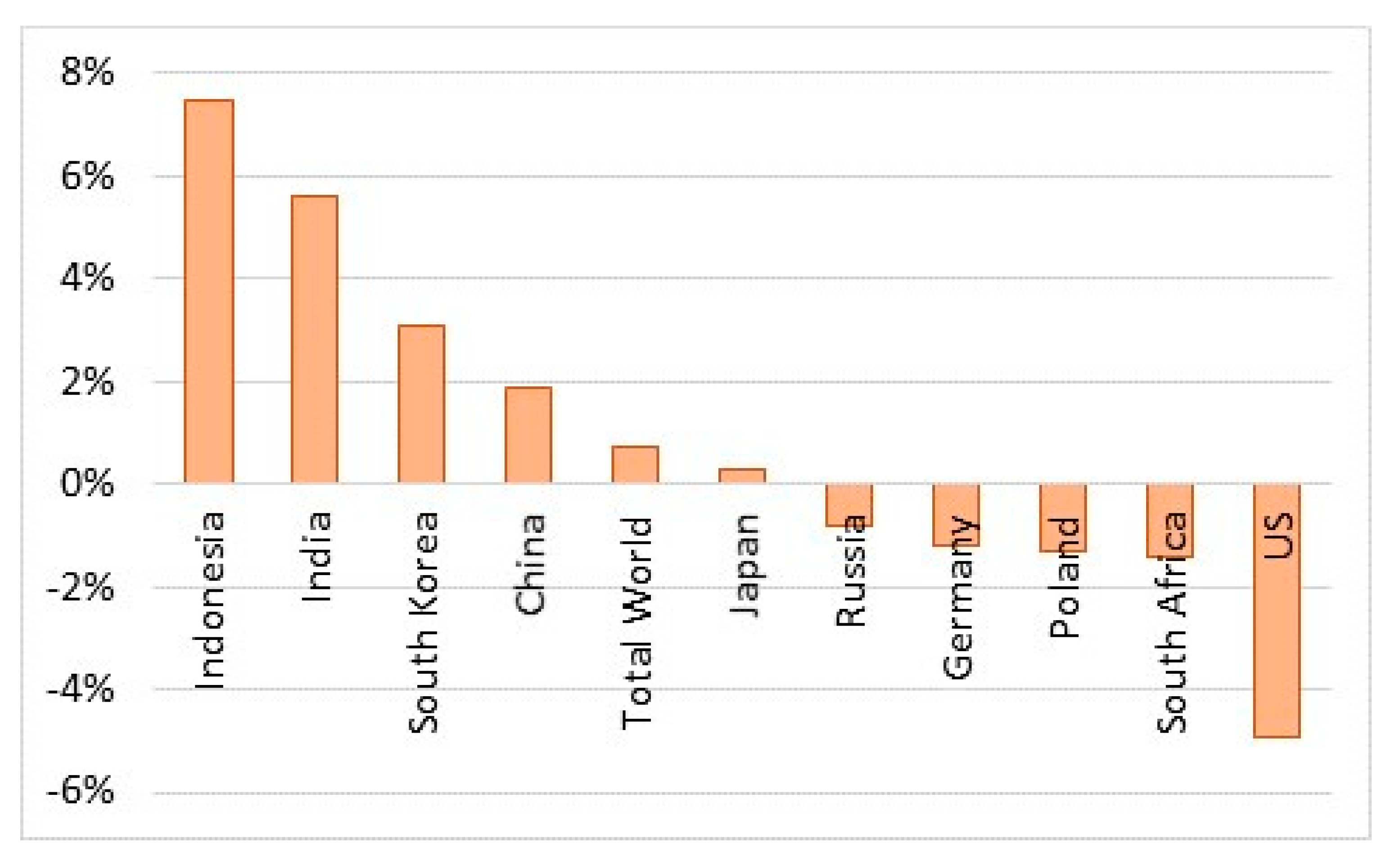

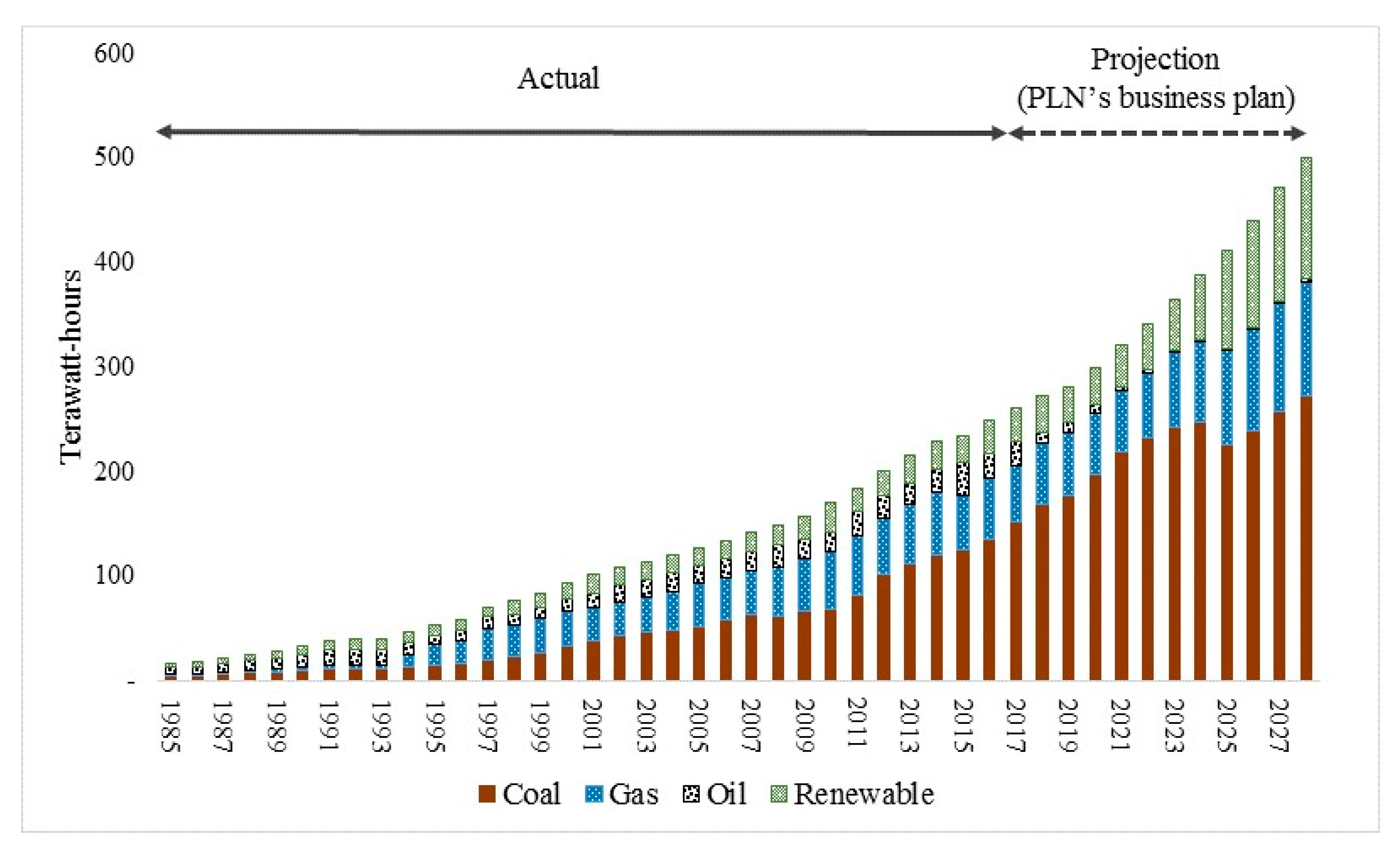
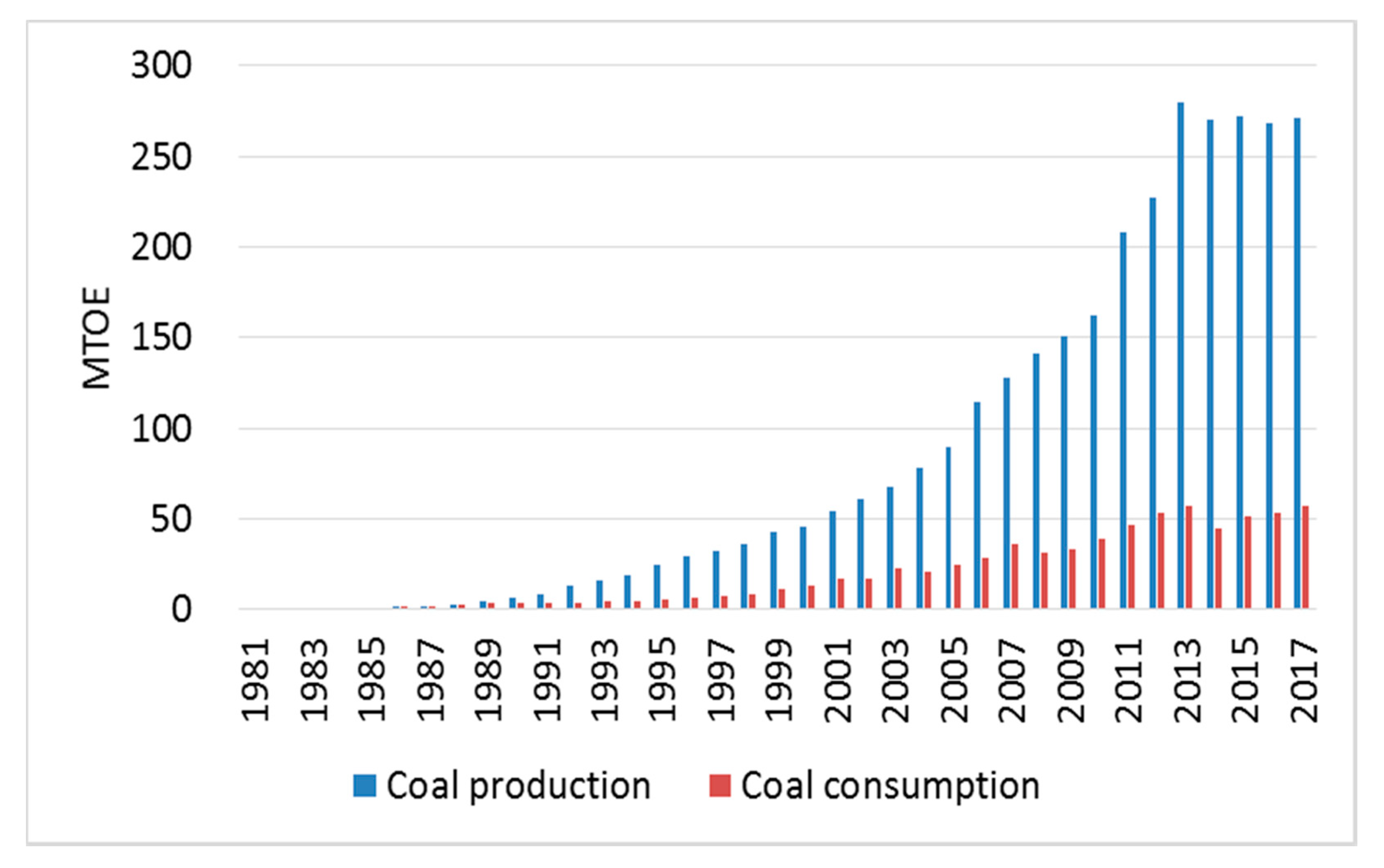
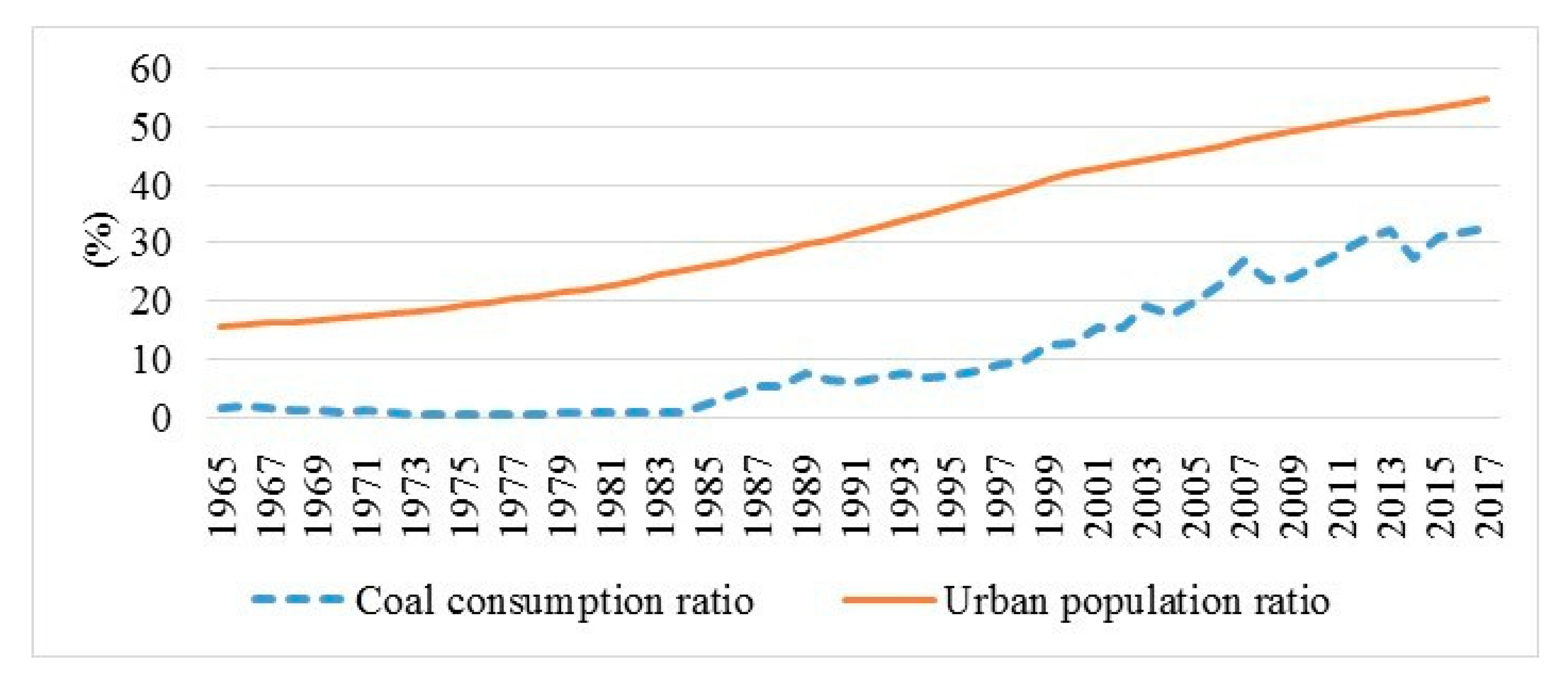
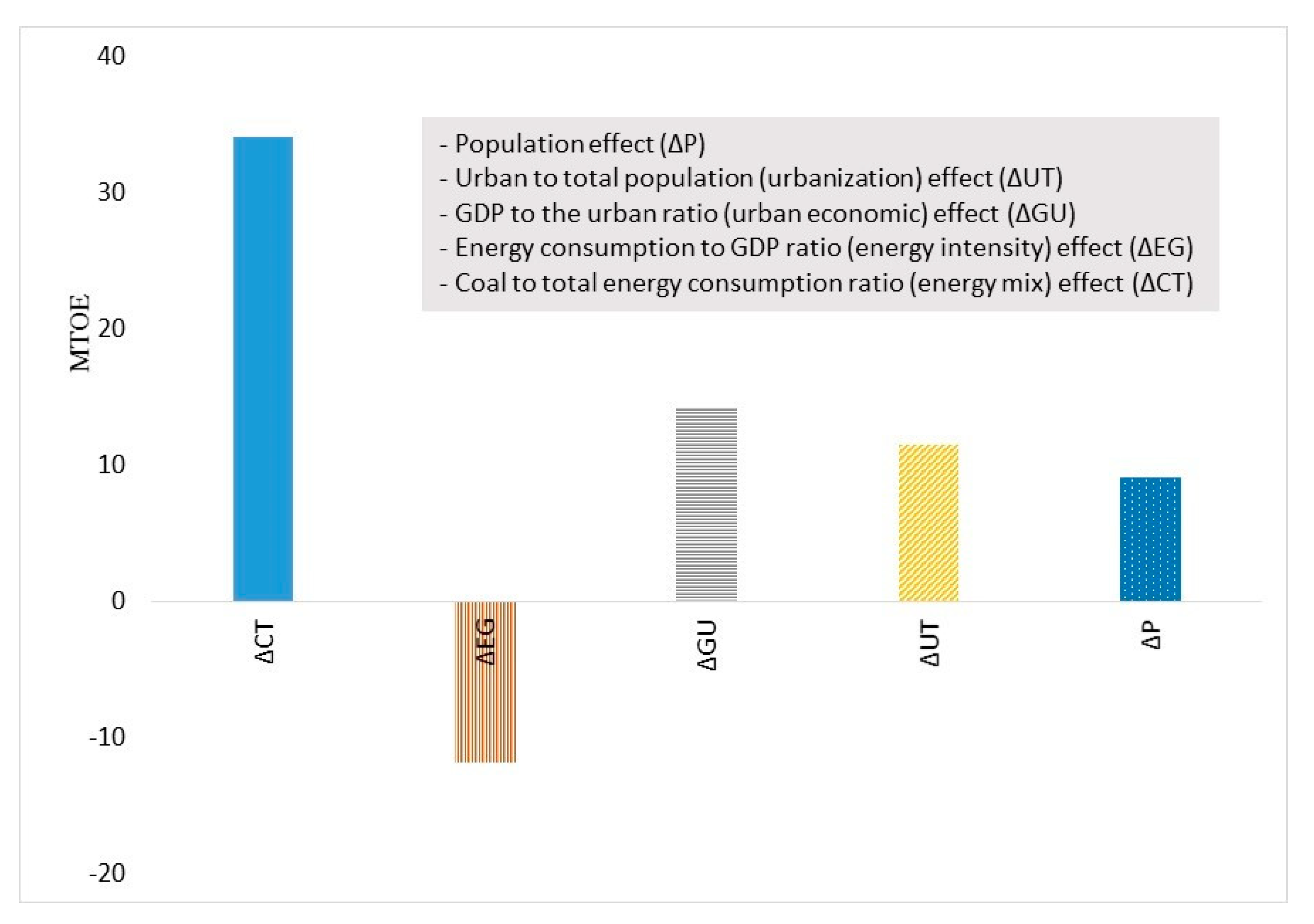
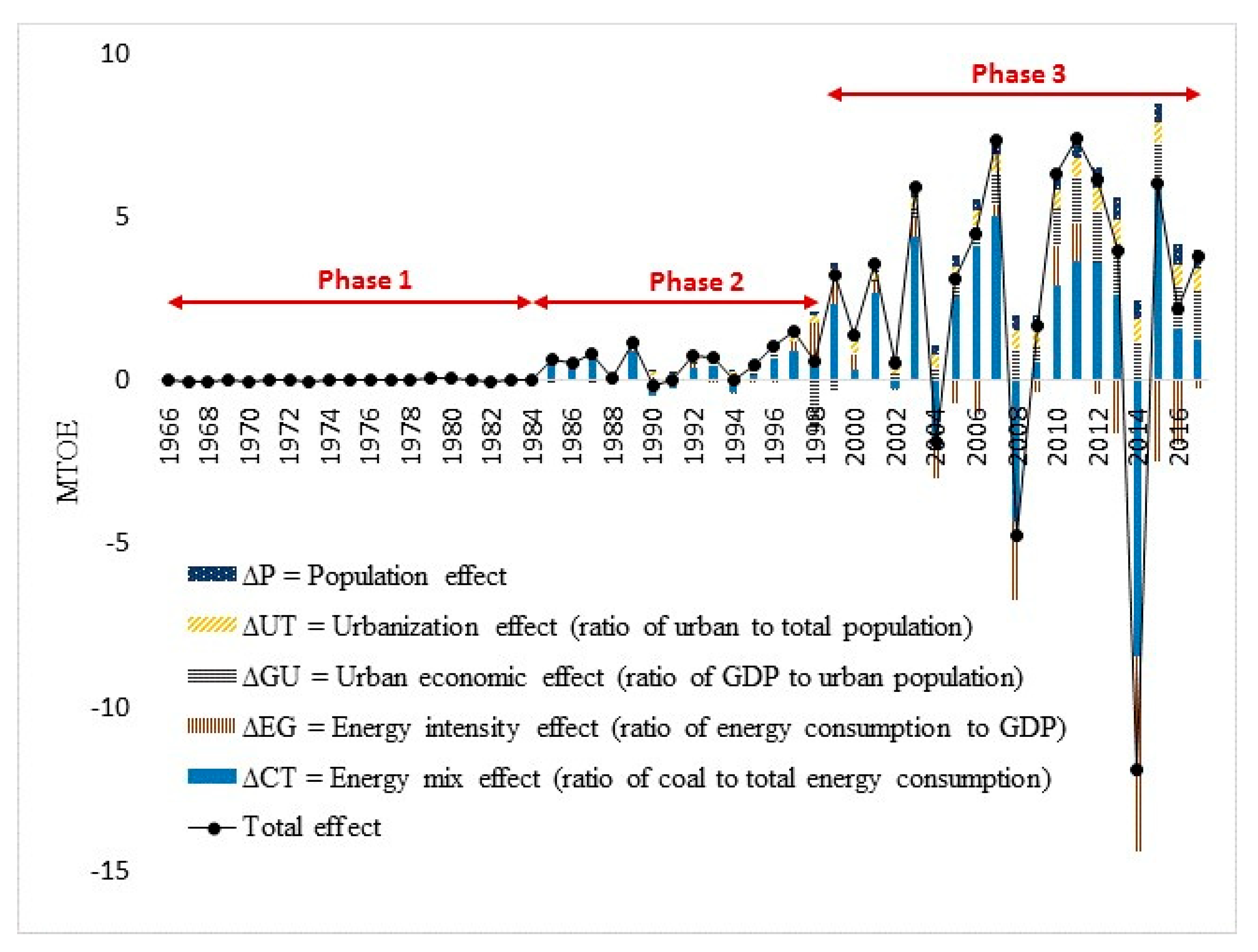
| Authors [Reference] | Method | Periods | Scope | Finding |
|---|---|---|---|---|
| Wang et al. [72] | PDA | 2005–2010 | China | Power plant emissions have been reduced by varying degrees due to different technologies. |
| Wang and Feng [74] | PDA | 2000–2014 | China | Emissions of the construction industry have increased in all provinces. |
| Chen and Duan [73] | PDA | 2001–2010 | China | The factors contributing to a reduction in CO2 emissions growth are technical efficiency, technological progress, and change in the output structure. |
| Wei et al. [76] | SDA | 2000–2010 | China (Beijing) | Increased emissions in Beijing were mainly caused by the metal and non-metal mining industries, power plants/utility sector and the construction industry. |
| Yuan and Zhao [77] | SDA | 2000–2010 | China | The main driver of decreasing emission in energy intensive industries is the technological effect. |
| Lan et al. [85] | SDA | 1990–2010 | Global | Population and affluence are the main driving forces of the energy footprint. |
| Wang et al. [86] | SDA | 1997–2012 | China | Industrial sector enhancement can significantly reduce coal consumption. |
| Tang et al. [65] | IDA: LMDI | 1997–2014 | China | Industrial structure shifting has compacted coal consumption significantly since 2012. |
| Zhang et al. [83] | IDA: LMDI | 1991–2013 | China | The industrial sector was the largest final user of coal, while power generation was the biggest coal consumer among all transformation sectors. |
| Yang et al. [68] | IDA: LMDI | 1990–2012 | China | The energy mix effect increased renewable energy consumption. |
| Chong et al. [84] | IDA: LMDI | 2001–2011 | China | Coal consumption has primarily been driven by the expansion of heavy industry. |
| Yeo et al. [87] | IDA: LMDI | 1990–2011 | China and India | The energy intensity effect is the main driving force of CO2 emissions reduction in the household sectors. |
| Chong et al. [88] | IDA: LMDI | 1978–2014 | Malaysia | End-use fuel-mix changes increased CO2 emissions in Malaysia |
| Reddy and Ray [82] | IDA: Sun’s method | 1991–2005 | India | The energy intensity effect has reduced energy consumption in all industries, except textiles. |
© 2020 by the authors. Licensee MDPI, Basel, Switzerland. This article is an open access article distributed under the terms and conditions of the Creative Commons Attribution (CC BY) license (http://creativecommons.org/licenses/by/4.0/).
Share and Cite
Kurniawan, R.; Trencher, G.P.; Edianto, A.S.; Setiawan, I.E.; Matsubae, K. Understanding the Multi-Faceted Drivers of Increasing Coal Consumption in Indonesia. Energies 2020, 13, 3660. https://doi.org/10.3390/en13143660
Kurniawan R, Trencher GP, Edianto AS, Setiawan IE, Matsubae K. Understanding the Multi-Faceted Drivers of Increasing Coal Consumption in Indonesia. Energies. 2020; 13(14):3660. https://doi.org/10.3390/en13143660
Chicago/Turabian StyleKurniawan, Robi, Gregory P. Trencher, Achmed S. Edianto, Imam E. Setiawan, and Kazuyo Matsubae. 2020. "Understanding the Multi-Faceted Drivers of Increasing Coal Consumption in Indonesia" Energies 13, no. 14: 3660. https://doi.org/10.3390/en13143660
APA StyleKurniawan, R., Trencher, G. P., Edianto, A. S., Setiawan, I. E., & Matsubae, K. (2020). Understanding the Multi-Faceted Drivers of Increasing Coal Consumption in Indonesia. Energies, 13(14), 3660. https://doi.org/10.3390/en13143660





